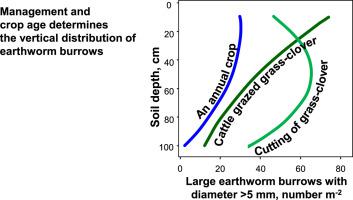European Journal of Soil Biology ( IF 3.7 ) Pub Date : 2021-02-17 , DOI: 10.1016/j.ejsobi.2021.103294 Paul Henning Krogh , Mathieu Lamandé , Martin Holmstrup , Jørgen Eriksen

|
Grass-clover is an important element in crop rotations due to its beneficial agronomic properties including nitrogen build-up, stimulation of earthworms and their burrowing and maintenance of soil macropores. We studied the relationship between important elements of grass-clover management in a crop rotation and earthworm diversity and macropore depth distribution, diameter and density from the ploughing layer to a depth of 1 m. Treatments included winter rye, 1st year cutting + slurry, 3rd year cattle grazing + slurry, 3rd year cutting + slurry and 3rd year cutting without slurry. The four-species earthworm assemblages and their burrow spatial structure responded distinctly to the temporal sequence of farming system management elements. The relative density of the endo-anecic and epi-anecic earthworm species, Aporrectodea longa and Lumbricus herculeus, was higher in the grass-clover phase of the rotation than under the annual crop, and increased with the age of grass-clover. The same was true for Aporrectodea rosea, but density and biomass of Aporrectodea caliginosa showed the opposite trend. Cattle grazing favours the occurrence of burrows (>5 mm ⌀) made by the anecics, A. longa and L. herculeus, while otherwise decreasing the number of fine-medium macropores (<5 mm ⌀) below the topsoil. Our study reveals the intimate interdependence between the cropping sequence and the earthworm burrow structure with low number of detectable burrows under annual crops, then increasing in number during the grass-clover over 3 years. The highest number of burrows was found at 0.5 m depth in 3rd year cutting ± slurry, presumably because there is no soil disturbance by tillage in this horizon. The density of the endogeic A. caliginosa was negatively correlated with the presence of burrows and sensitive to grazing cattle compacting the topsoil. Positive correlations between burrows and density of L. herculeus indicate that this species was responsible for the burrows at one m depth while the density of A. longa was positively correlated with the burrows in the Ap horizon. We discuss the species composition in the grass-clover rotation system and its influence on soil ecosystem functioning.
中文翻译:

worm洞穴数量和垂直分布受草-三叶草轮作系统作物序列的影响
草三叶草是作物轮作中的重要元素,因为它具有有益的农艺特性,包括氮积累,stimulation刺激以及它们的穴居和土壤大孔的维持。我们研究了作物轮作中三叶草管理的重要要素与worm的多样性以及耕作层至深度为1 m的大孔深度分布,直径和密度之间的关系。处理方法包括冬季黑麦,第一年cutting割+泥浆,第三年牛放牧+泥浆,第三年cutting割+泥浆和第三年无泥slurry。四种worm组合及其洞穴的空间结构对耕作系统管理要素的时间顺序有明显的反应。内消ane和上消ane earth的相对密度,轮作草三叶草期的长孢粉虫(Aporrectodea longa)和Lu草(Lumbricus herculeus)高于一年生作物,并且随着草草年龄的增加而增加。玫瑰圆孢子菌也是如此,但是加倍线虫的密度和生物量却呈现相反的趋势。放牧的牛有利于食角菌A. longa和L.herculeus产生洞穴(> 5 mm⌀),同时减少表土以下的中型大孔(<5 mm⌀)的数量。我们的研究表明,种植顺序与the的洞穴结构之间存在密切的相互依存关系,一年生作物下可检测到的洞穴数量很少,然后在三年多的草三叶草中数量增加。在第3年开挖±泥浆的深度最大的洞穴是在0.5 m处发现的,这大概是因为在该层位中没有耕作对土壤的干扰。内生A. caliginosa的密度与洞穴的存在负相关,并且对放牧的牛压实表土敏感。穴位与L密度呈正相关。大力神表明该物种是造成1 m深度洞穴的原因,而长曲霉的密度与Ap水平的洞穴正相关。我们讨论了草-三叶草轮作系统中的物种组成及其对土壤生态系统功能的影响。











































 京公网安备 11010802027423号
京公网安备 11010802027423号